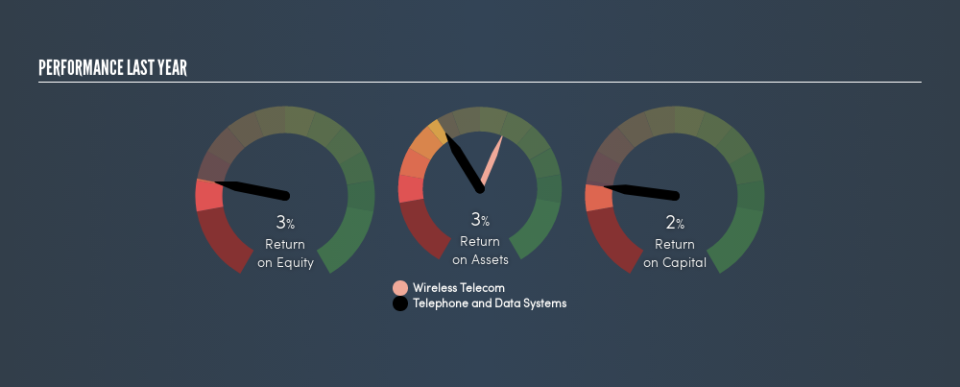Telephone and Data Systems, Inc. (NYSE:TDS) Might Not Be A Great Investment

Today we'll look at Telephone and Data Systems, Inc. (NYSE:TDS) and reflect on its potential as an investment. Specifically, we're going to calculate its Return On Capital Employed (ROCE), in the hopes of getting some insight into the business.
First, we'll go over how we calculate ROCE. Next, we'll compare it to others in its industry. And finally, we'll look at how its current liabilities are impacting its ROCE.
Return On Capital Employed (ROCE): What is it?
ROCE measures the 'return' (pre-tax profit) a company generates from capital employed in its business. Generally speaking a higher ROCE is better. Overall, it is a valuable metric that has its flaws. Renowned investment researcher Michael Mauboussin has suggested that a high ROCE can indicate that 'one dollar invested in the company generates value of more than one dollar'.
How Do You Calculate Return On Capital Employed?
Analysts use this formula to calculate return on capital employed:
Return on Capital Employed = Earnings Before Interest and Tax (EBIT) ÷ (Total Assets - Current Liabilities)
Or for Telephone and Data Systems:
0.021 = US$207m ÷ (US$11b - US$925m) (Based on the trailing twelve months to June 2019.)
Therefore, Telephone and Data Systems has an ROCE of 2.1%.
See our latest analysis for Telephone and Data Systems
Is Telephone and Data Systems's ROCE Good?
ROCE is commonly used for comparing the performance of similar businesses. In this analysis, Telephone and Data Systems's ROCE appears meaningfully below the 6.1% average reported by the Wireless Telecom industry. This performance is not ideal, as it suggests the company may not be deploying its capital as effectively as some competitors. Independently of how Telephone and Data Systems compares to its industry, its ROCE in absolute terms is low; especially compared to the ~2.7% available in government bonds. There are potentially more appealing investments elsewhere.
You can click on the image below to see (in greater detail) how Telephone and Data Systems's past growth compares to other companies.
When considering this metric, keep in mind that it is backwards looking, and not necessarily predictive. Companies in cyclical industries can be difficult to understand using ROCE, as returns typically look high during boom times, and low during busts. ROCE is only a point-in-time measure. Future performance is what matters, and you can see analyst predictions in our free report on analyst forecasts for the company.
Telephone and Data Systems's Current Liabilities And Their Impact On Its ROCE
Current liabilities are short term bills and invoices that need to be paid in 12 months or less. The ROCE equation subtracts current liabilities from capital employed, so a company with a lot of current liabilities appears to have less capital employed, and a higher ROCE than otherwise. To counter this, investors can check if a company has high current liabilities relative to total assets.
Telephone and Data Systems has total liabilities of US$925m and total assets of US$11b. As a result, its current liabilities are equal to approximately 8.6% of its total assets. Telephone and Data Systems has a low level of current liabilities, which have a negligible impact on its already low ROCE.
The Bottom Line On Telephone and Data Systems's ROCE
Nevertheless, there are potentially more attractive companies to invest in. Of course, you might also be able to find a better stock than Telephone and Data Systems. So you may wish to see this free collection of other companies that have grown earnings strongly.
If you are like me, then you will not want to miss this free list of growing companies that insiders are buying.
We aim to bring you long-term focused research analysis driven by fundamental data. Note that our analysis may not factor in the latest price-sensitive company announcements or qualitative material.
If you spot an error that warrants correction, please contact the editor at editorial-team@simplywallst.com. This article by Simply Wall St is general in nature. It does not constitute a recommendation to buy or sell any stock, and does not take account of your objectives, or your financial situation. Simply Wall St has no position in the stocks mentioned. Thank you for reading.

